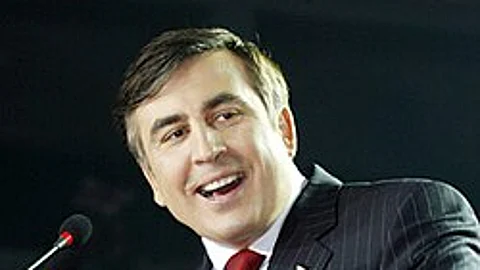

The former President of Georgia, and past hero of the EU/NATO collective, Mikheil Saakashvili has recently been handed a 12 and a half year sentence, given his deteriorating health, its more likely a death sentence.
Before Volodymyr Zelensky received dazzled the Western elite with his green outfits and received standing ovations at every capital he spoke to, there was Mikheil Saakashvili. The parallels between these two men are many. Saakashvili, like Zelensky, sealed his fate by choosing to go to war with Russia on NATO's behalf.
The Rose Revolution
Mikheil Saakashvili emerged in 2001 as a young, reformist, leader of the opposition to then President Eduard Shevardnadze. In November of 2003, when Shevardnadze's party secure a victory in parliamentary elections, Saakashvili and his supporters, backed by Western NGOs protested the results, which eventually led to the fall of Shevardnadze's party and the President himself. This would be the first "color revolution" to take place within the former Soviet Union.
Saakashvili and his party, United National Movement, would sweep into power unopposed. Afterwards, he would take Georgia on a Western oriented track to join the EU and NATO, while the U.S. designated Georgia a major non-Nato ally and began to arm and train the Georgian army over the next 4 years.
The new, young, charismatic President would be lauded in the Western press as a champion of democracy and a reformer who sought to shed Georgia's Soviet past and rightfully bring Georgia home to its European roots.
Five Day War
In April of 2008, at the annual NATO summit which was held in Bucharest, NATO formally invited Georgia and Ukraine, who had also had a color revolution in 2004, to join the alliance. Much to the objection of Russian President Vladimir Putin who also attended the summit.
However, Georgia had a similar issue that Ukraine would have going into 2022, the two breakaway regions of Abkhazia and South Ossetia, who had declared independence after the fall of the Soviet Union and who also had a presence of Russian peacekeepers protecting their de facto independence.
In June of 2008, Saakashvili would meet with Dmitry Medvedev, who had just become the President of Russian the previous month, to talk about opening up negotiations regarding the two breakaway regions. Medvedev would go on to tell the Georgian leader that Georgia must commit to not joining NATO before Russia would consider reunification.
Next, according to Saakasvili himself, Condoleezza RIce, then U.S. Secretary of State under President George W. Bush, reminded him of the powerful army the U.S. had built for Georgia and implied that he he would have the support of the U.S. should he choose to use it.
During July, the Georgian military would mobilize and begin massing along the contact line, and on August 7th, would attack South Ossetia. The Russian military would respond quickly, defeating the Georgian Army in five days, capturing about a fifth of Georgia proper and had a clear path to Tbilisi after the government and military fled south. Instead they chose to honor a ceasefire and eventually withdrew back out of Georgia, not before capturing and/or destroying most of Georgia's military capabilities, including the entirety of their navy.
On August 26th, Russia would recognize the independence of Abkhazia and South Ossetia, ensuring permanent Russian presence in the regions and dashing Georgia's dreams of joining NATO.
Aftermath
After the war, public opinion turned on Saakashvili, who now had made many enemies in Georgia, in 2012 his party would lose parliamentary elections to the Georgian Dream Party, and he knew that his freedom depended on remaining President. He tried to run for a third term but was banned from running in the 2013 election, and would leave Georgia for Ukraine in November of 2013 just in time for the Maidan Revolution and would get become the governor of Odessa Oblast in 2015, all the while being wanted in Georgia on corruption and fraud charges.
in October of 2021, he would make the curious choice to return to Georgia and called on his supporters to march on Tbilisi, where he was then promptly arrested and has been imprisoned ever since.
The Saakashvili of Ukraine
President Zelensky would have a lot to gain by learning from Saakashvilis experience. While it can be debated on if Russia was provoked or not in February of 2022 when they invaded Ukraine, one thing that cannot be debated is that in April of 2022, Zelensky chose to go to war for the West, and walked away from negotiations that were taking place in Istanbul, were a draft treaty had already been agreed upon, in return for an unlimited weapons and money supply to fight Russia.
U.S. Secretary of State Marco Rubio has even admitted the war in Ukraine is a proxy war between the U.S. and Russia. A war Russia has won, and the U.S. wants out. Zelensky will almost certainly not remain in power after the war, neither will a pro-Western government in Kiev. Zelensky, like his Georgian counterpart, has made many enemies and the number of people who want to see him go are numerous.
Bin Laden was once hailed as a freedom fighter in the 1980's, before he became the world's most wanted man. Ahmed al-Sharaa was until recently one of the most wanted men in the world, until he became the democratic jihadist reformer of Syria. Mikheil Saakashvili was once the golden child of Western liberalism, and now he's just a corrupt former president in prison. The pendulum will always swing depending on your usefulness to the West, and Volodymyr Zelensky will go from being the second incarnate of Winston Churchill, to something much less appealing, maybe at the expense of his freedom.